Robert Power
The CSAM Framework
This section provides an overview of the Collaborative Situated Active Mobile (CSAM) learning design framework, and the work that has been done with CSAM (including my doctoral dissertation research in the Doctor of Education in Distance Education program with the Center for Distance Education at Athabasca University, Canada).
What is CSAM?
- CSAM stands for Collaborative Situated Active Mobile learning design strategies.
- CSAM is a distillation of the key pedagogical elements guiding the instructional designs of case studies of the use of mobile RLOs to facilitate collaborative learner interaction.

The following table from Power (2013) summarizes the use of CSAM for reflective practice:
Table 7.1
CSAM guided questions for reflective practice
| C | Collaborative | Does your mLearning design provide learners with an opportunity to collaborate?
|
| S | Situated | Is your learning activity situated in a realistic context?
|
| A | Active | Do your learners have an opportunity to do something with the content they encounter in your mLearning activity?
|
| M | Mobile | Does your mLearning design free learners from the tether of traditional classroom routines?
|
CSAM in the Literature
CSAM learning design is represented in approximately one fifth of all chapters and articles analyzed in a meta-analysis of mobile learning publications between 2009-2014. The CSAM pedagogical components were represented in 86% of the chapters and articles that were about mobile RLOs, or that included mobile RLOs as supporting examples. Of the mobile RLOs that were described as supporting collaborative learning, 96% integrated all four CSAM pedagogical elements.

CSAM and Learning Theory
The development of the CSAM learning strategies framework has been influenced by Koole’s (2009) Framework for the Rational Analysis of Mobile Education (FRAME) model. Like FRAME, CSAM is congruent with:
- Transcactional Distance Theory
- Activity Theory and the Zone of Proximal Development
You can learn more about the theoretical underpinnings of CSAM by reading my paper in Learning and Teaching in Higher Education: Gulf Perspectives, or from my poster on CSAM presented at the Mobile Learning: Gulf Perspectives Symposium in Abu Dhabi, United Arab Emirates, in April 2013.

Supporting Models and Frameworks
CSAM is also congruent with:
CSAM Teacher Professional Development MOOC
The CSAM Professional Development course was originally developed for a research study to investigate the impact of the CSAM learning design framework on teachers’ perceptions of comfort, confidence, and interest in integrating mobile RLOs into their teaching practice.
The first version of the CSAM course was called Creating Mobile Reusable Learning Objects Using Collaborative Situated Active Mobile (CSAM) Learning Strategies. The course was created using the Canvas learning management system, and was run as a professional development course as part of my dissertation research.
Current Versions
The are two new versions of the CSAM course created using the Canvas LMS. The first is called Mobile Reusable Learning Objects and the CSAM Framework. That course is designed to be used for workshop presentations, as an introduction and overview for mobile learning teachers who are looking for new ways to provide professional development opportunities at their own institutions. You can use the link below to self-register in that course now, if you want to take a look around!
http://tinyurl.com/mobile-csam
A second new version is called The CSAM RLO – Creating Mobile Reusable Learning Objects Using the CSAM Learning Design Framework. That course is similar to the original PD course developed for my dissertation research study, and is available for download as a Master Course Pack file. The course is an open educational resource (OER), and can be imported, ready to go, into new course shells created in Canvas!
How it Works:
- Download a copy of the CSAM RLO Master Course Pack
- Extract the .zip file
- Create your own free teacher account at Canvas (if you do not already have one!)
- Create a new course
- Import the CSAM RLO course content from the CSAM RLO Master Course Pack
- Edit the course information as required, set your course dates, and go!
Citing the CSAM RLO Course
The CSAM RLO course and Master Course Pack are open educational resources, posted using a Creative Commons attribution. Please cite them as follows:
Power, Robert (2014). Creating mobile reusable learning objects using the CSAM learning design framework. Available from http://robpower.weebly.com/csam-mooc.html
More Information
Visit the CSAM website.
